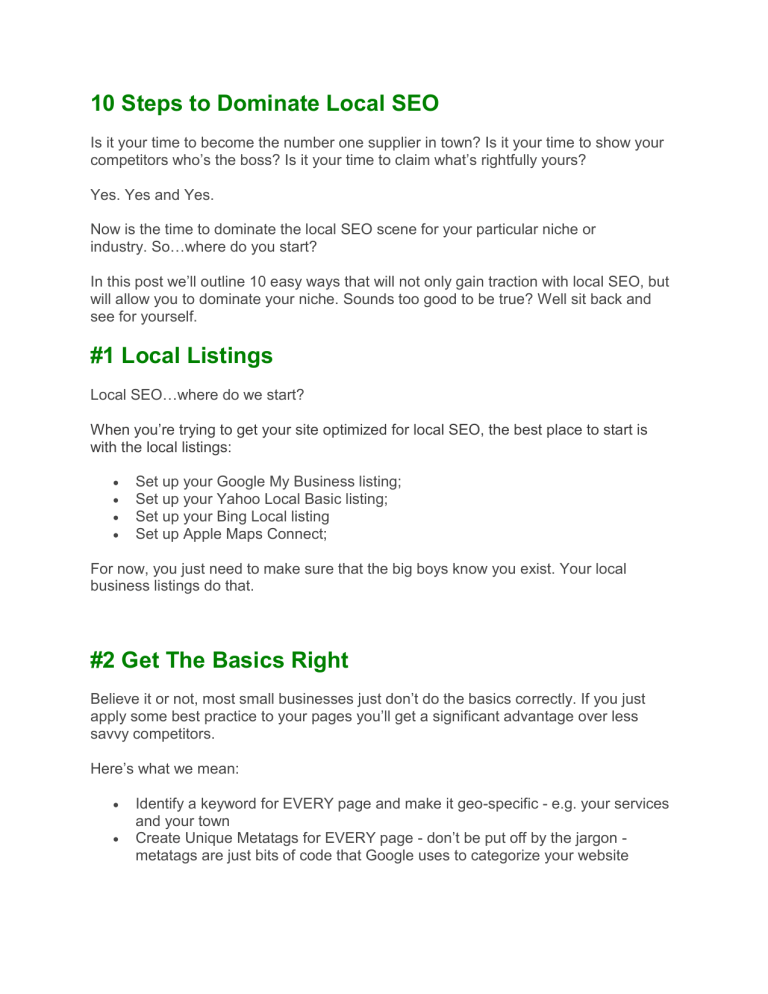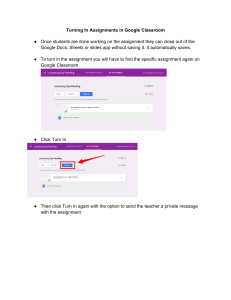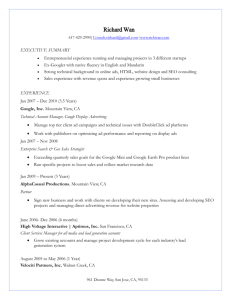
10 Steps to Dominate Local SEO Is it your time to become the number one supplier in town? Is it your time to show your competitors who’s the boss? Is it your time to claim what’s rightfully yours? Yes. Yes and Yes. Now is the time to dominate the local SEO scene for your particular niche or industry. So…where do you start? In this post we’ll outline 10 easy ways that will not only gain traction with local SEO, but will allow you to dominate your niche. Sounds too good to be true? Well sit back and see for yourself. #1 Local Listings Local SEO…where do we start? When you’re trying to get your site optimized for local SEO, the best place to start is with the local listings: Set up your Google My Business listing; Set up your Yahoo Local Basic listing; Set up your Bing Local listing Set up Apple Maps Connect; For now, you just need to make sure that the big boys know you exist. Your local business listings do that. #2 Get The Basics Right Believe it or not, most small businesses just don’t do the basics correctly. If you just apply some best practice to your pages you’ll get a significant advantage over less savvy competitors. Here’s what we mean: Identify a keyword for EVERY page and make it geo-specific - e.g. your services and your town Create Unique Metatags for EVERY page - don’t be put off by the jargon metatags are just bits of code that Google uses to categorize your website Create Keyword Rich URLs for EVERY page - eg: don’t call your pages www.mybusiness.com/services - better to use - www.mybusiness.com/myservice-my-town Add your keywords to Headings on EVERY page - Headings are like the ones you use when you create a document in Word. Google uses them to understand the layout of the page. Use H1, H2 and H3 headings on each page Create long pages (see below) and include your keywords in the text and link to other pages in your website using these keywords Optimize any images you have on your pages - Google can’t understand images so you need to describe the content of them #3 Go Mobile The web is going mobile - big time. And don’t think that only applies to big business. Think about your potential customers - are they sitting at home or in an office browsing on their desktop? No - if they’re anything like you (and they are) they’re out and about browsing with their mobiles or their tablets. Still not convinced? Well we know from an August 2015 report that “18% of local mobile searches lead to a sale within one day” and “local searches lead 50% of mobile visitors” to your ecommerce store “within one day.” Back in May 2015 it was reported that mobile traffic had overtaken desktop traffic as well, making up 29% of all search traffic. Mobile is how people are finding what to do in their local area. For your local business, this is great. First up, check if your site is mobile friendly. If it isn’t then one option is to build a responsive website which can be viewed perfectly on any device. If budget is an issue then look at a low cost option such as a mobile website builder where you can create a basic mobile site which operates side by side with your normal site and displays when a mobile browser is detected. #4 Be Location Specific One of the biggest problems that sites run into is that they’re not specific. By specific, we mean your location. Your Site Needs Location-Specific Content Your Site Needs Location-Specific Pages Your Site Needs Good Citations Your Site Needs to Avoid Multiple or Incorrect Listings on Google The good news is that you can get all of this through your content alone…and it’s super easy. Just add your Name, Address and Phone to your contact page! We call that NAP and Google loves to see it. When it does see it you’ll start to get those good citations, something that boosts traffic from your local area. #5 Get on the Local SEO Map Are you a SAB? An SAB is a service-area business and if you qualify you’ll do even better on Google. A good place to start is with a Moz post called Getting on the Map: The Intro to Local SEO for SABs The tips are for brick and mortar stores, the kind that have a physical location and hours of operation like we talked about earlier. A good tip is defining your service in an exact and specific way so Google picks up on it. The more generic, the more Google ignores you. The more specific, the more Google will pay attention to you. And please – check those duplicate listings! Having the same name as another business is one thing. When it’s in the same area it might cause you problems. When it’s online, you’ll experience even more headaches. So define your service exactly and get better results because of it. #6 Content Marketing for Local SEO Content Marketing is becoming increasingly important for business of all sizes and in all markets. Google loves all that shiny, new, relevant content. If your website is just static and never has any new content then over time Google will just ignore you. So what you need is targeted content marketing, the kind that taps into the basic wants and needs, the core desires, of those local SEO searchers You can add that content to your blog, promote it on social media, use it to build relationships with bloggers an people who can promote it to their audience. So Content Marketing is the place where online search, blogging and social media all meet. If you’re still scratching your head then a good place to start is with a Definitive Guide to eCommerce Content Marketing infographic which takes you step by step through the process. Here, take a look: The main takeaways here are that Content Marketing is a predictable, repeatable process that anyone can master. If you’re really stuck with Content Marketing there are loads of types of content that are proven to increase traffic and conversions (i.e. people who come to your website and become clients). Here are five particularly effective types of content: Definitive Guides How To Guides Buyer’s Guides List Based Content Case Studies #7 Target Focused Geographic Areas Are you using Google Analytics geo-targeting feature? Pretty much it’s just looking at the large map of your geographic area to figure out which smaller areas are giving you the most traffic. Let’s say you’re in West Australia. That’s a huge metropolitan area and has tons of smaller municipalities, suburbs, and locales. That’s why Lilo in Perth suggested focusing your local SEO content and local SEO marketing to a demographic area as large as West Australia doesn’t make a lot of sense. You’ll need to drill down further, targeting all those smaller circles around it so you can get even more traffic to your site. So consider writing content for places like Perth, Albany, Rockingham and other geographic areas in the larger area. Once you have this list of areas you can add these to your pages, either in the URLs (the website address) as well as in the text of each page. It’s just another way to get ahead of the competition by focusing on areas they ignore. #8 Create Product and Service Specific Pages Often local business websites have ‘thin’ content. What we mean by this is that the website includes the very basic information about the business. That’s a mistake. Why? Because Google wants more content. It wants to see specific pages talking about specific products or services. For example, let’s say that you are a local plumber. You offer a range of call-out services for emergencies but you also have project services like kitchen plumbing installation, bathroom installation, boiler installation, heating installation, external drainage, etc... Instead of having just one ‘Services’ page listing them, create a page for each. This way you are casting a wider net with Google. You are creating service specific pages that reflect what people are actually searching on. Also, make the pages quite long - say between 500 to 1500 words. That might sound like a lot, but think about it. If we sat down for a coffee and you started to explain what you do for each service you could probably talk for hours. So just have that imaginary conversation with your prospects, listen to the questions they have and that will give you that content. That's all there is to it - just list out all of the products and services you offer and create a page for each with loads of useful information. #9 Encourage Reviews You love your customers and you want them to know that. When they do, they’ll return that love. Today, returning that love means leaving reviews. For local SEO, reviews are critical. We know from an August 2015 post that “88% of consumers trust online reviews as much as personal recommendations.” Sites that have reviews move up the search results like no other. When it comes to local listings, this is even truer. You have a lot of different ways to gain local SEO traffic. Reviews are one of the best ways because people see them right on the main Google search page: If you type in New York City pizza this listing is one of the first to come up. A big reason for that are the 242 customer reviews the place has. For comparison’s sake, look at the other top restaurants that came up for that search query: As you can see, the restaurant we chose doesn’t have the most reviews. The third result has 800 more reviews! The reason that restaurant came up first is because the average of its reviews is 4.4 stars while the other restaurant has 4.0 stars. So review quality is more important than the number of reviews. Again, you love your customers – make sure they know it! A word of caution though. Don’t try to game the system with either fake reviews or by getting tons of reviews in a short space of time. Either of these can get your business banned from the listings. Just take your time and do it slowly but surely and you’ll be just fine. #10 Study the Competition You can learn so much about what your customers want if you just look at your competition. What are they putting on their blog? What product promos are they doing this month or season? What are their social efforts and how is this keyed to their site? When you look at those things you’ll get a clear idea of what the market expects. You’ll also get an idea of what you’re not doing, or perhaps things that are working that you should try. Beside that, you’ll see your competition’s contact page, how they list their NAP info, and what they’re doing for local SEO efforts. That goes doubly so for their blog. Take a look at what content is put up, how often, and how many comments it gets. Are they targeting to specific audiences and needs or just going with general talking points you could see on the other side of the country? Study all of these things so you can do them better than the competition. Conclusion Local SEO is something you can dominate. Just remember to do the basics right. That means getting listed in local listings like Google, Bing and Yahoo and getting plenty of NAP Citations. It means optimizing your pages and making sure you have plenty of content on specific product and service pages. You’ll need to get geo-specific and focus in on the areas you cover rather than trying to cover a major city. Also, be aware that people are searching for you on their phones and mobile devices nowadays so make sure your website passes the mobile test. Content is important too and Google loves all that fresh, relevant content. You’re going to need to get reviews too - especially in Google. I hope you find that useful and good luck on your journey to the top!


